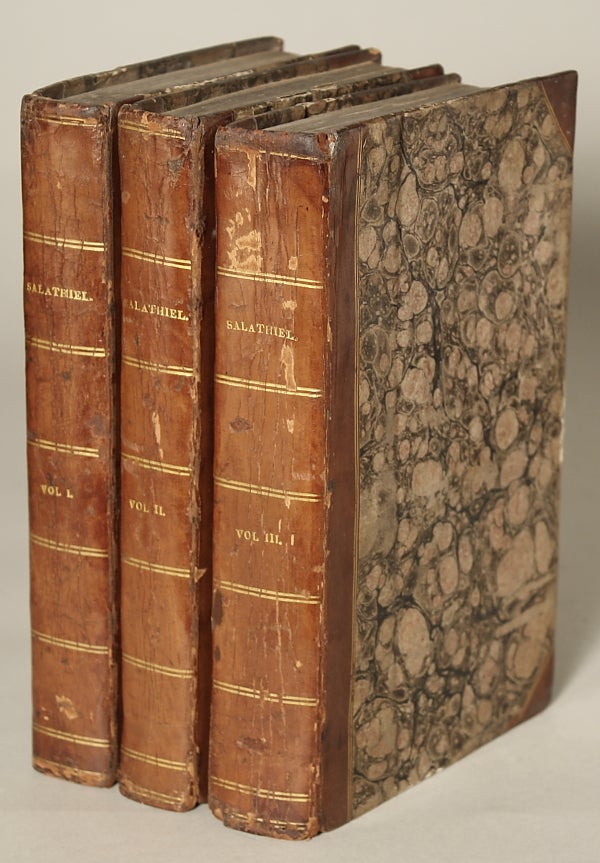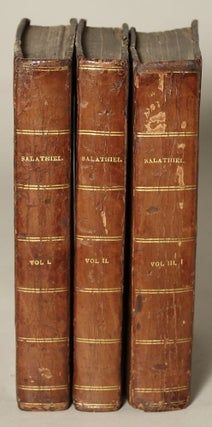SALATHIEL. A STORY OF THE PAST, THE PRESENT, AND THE FUTURE. In Three Volumes. London: Henry Colburn, New Burlington Street, 1828. 12mo, three volumes: pp. [i-v] vi-viii [1] 2-338 [note: final leaf, P1, is a single inset]; [i-ii] [1] 2-324; [i-ii] [1] 2-417 [418: blank] [note: first leaf of final signature, S1, is a single inset], nineteenth-century three-quarter brown leather and marbled boards, all panels stamped in gold. First edition. Published anonymously. The first of two novels published by George Croly (1780-1860), Irish clergyman, poet and miscellaneous writer, a popular gothic tale of the Wandering Jew. "The motif of the Wandering Jew has been used for a variety of literary purposes down through the ages, though it has attracted more interest from European than American writers (where it has tended to merge with the Flying Dutchman in such displaced forms as 'Peter Rugg' and 'The Man Without a Country'). One looks for fresh variations on the theme as well as overall literary ability, and Croly supplied both in this long novel. Its most direct genre affinity is with the romantic historical fiction of Walter Scott, the setting here being the Mediterranean world of the first century. The curse from Jesus (whom the Jew famously refused to help on his way to his crucifixion) is the starting point. The Jew's full understanding of his doom is the story's ending point. In between he encounters 'dreadful visions, imagined journeys through space, shipwrecks, hunger and thirst, violence of all kinds both real and imaginary' (Anderson, The Legend of the Wandering Jew, pp. 188-9). He emerges as a generally sympathetic adventure hero, the first time he was portrayed as a Jewish nationalist resisting both Romans and Christians, and as an unwitting inspiration to future rebels and innovators -- a doomed Byronic hero, in other words (Byron called the author 'roly-poly Croly'). In his definitive treatment of the Wandering Jew legend, George K. Anderson gives considerable space to SALATHIEL and, in comparing it to Maturin's contemporary tale of another doomed immortal, MELMOTH THE WANDERER (1820), declares Croly's work superior as literature (ibid., p. 189). While this judgment will strike most readers as controversial, to say the least, it does suggest that Croly's work does not deserve its present obscurity." - Robert Eldridge. "Croly's best known work, his novels, are a sort of combination imitation of Byron, De Quincey, and Moore. They are thoroughly meretricious and sensational, but colorful and bold, and SALATHIEL at least was very popular in its day." (Kunitz and Haycraft) "An impressive example of Gothic romance, on the old theme of the Wandering Jew, embellished with oriental scenery and oriental grandiloquence." (Baker). Frank, The First Gothics 77. Bleiler (1978), p. 53. Reginald 03632. Garside, Raven & Sch werling 1828:32. NCBEL III 375. Sadleir 661. Wolff 1633. Early oval ink ownership stamp of R. A. Heaver on the front and rear endpapers of each volume, contemporary book label of Mordaunt M. Fitzgerald affixed to front paste-downs of volumes one and two. Bindings rubbed, light foxing and stains to text blocks, a very good copy. (#137517).
Price: $750.00
No statement of printing.



